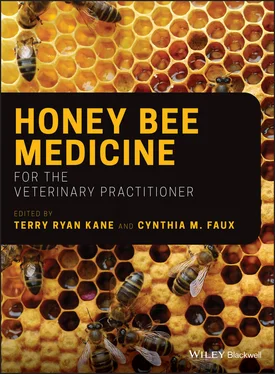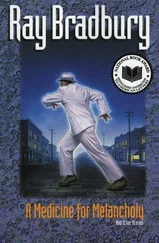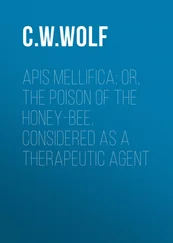Jerry HayesEditor Bee Culture Magazine Medina, OH, USA
Brandon K. Hopkins, PhDDepartment of Entomology Washington State University Pullman, WA, USA
Charlotte HubbardSchoolcraft, MI, USA www.hubbardhive.com
Adam J. Ingrao, PhDU.S. Army Veteran Michigan Co‐Coordinator USDA North Central Region Sustainable Agriculture Research and Education Program (NCR‐SARE); Extension Specialist Michigan State University Extension MI, USA
Reed M. Johnson, PhDAssociate Professor Department of Entomology The Ohio State University Wooster, OH, USA
Britteny Kyle, DVMDepartment of Population Medicine Ontario Veterinary College University of Guelph Ontario, Canada
Katie Lee, PhDDepartment of Entomology University of Minnesota Bee Research Facility St. Paul, MN, USA
Marcie Logsdon, DVMDepartment of Veterinary Clinical Sciences College of Veterinary Medicine Pullman, WA, USA
Margarita M. López‐Uribe, dPhDLorenzo L. Langstroth Early Career Professor Assistant Professor of Entomology Department of Entomology Center for Pollinator Research Penn State University University Park, PA, USA
Scott McArt, PhDDepartment of Entomology College of Agriculture and Life Sciences Cornell University Ithaca, NY, USA
Meghan Milbrath, PhDMichigan Pollinator Initiative Department of Entomology Michigan State University East Lansing, MI, USA
Kristen K. Obbink, DVM, MPH, DACVPMCenter for Food Security and Public Health Iowa State University College of Veterinary Medicine Ames, IA, USA
Randy Oliver, MSScientificBeekeeping.com
David T. Peck, PhDDepartment of Entomology Cornell University Ithaca, NY, USA
Robin W. Radcliffe, DVM, DACZMDirector, Cornell Conservation Medicine Program Department of Clinical Sciences College of Veterinary Medicine Cornell University Ithaca, NY, USA
Rolfe M. Radcliffe, DVM, DACVS, DACVECCLecturer, Large Animal Surgery and Emergency Critical Care College of Veterinary Medicine Cornell University Ithaca, NY, USA
Kasie Raymann, Ph.DDepartment of Biology University of North Carolina at Greensboro Greensboro, NC, USA
Gary S. ReuterApiculture Technician Department of Entomology University of Minnesota Bee Research Facility St. Paul, MN, USA
James A. Roth, DVM, MS, PhD, ACVMCenter for Food Security and Public Health Iowa State University College of Veterinary Medicine Ames, IA, SA
Olav Rueppell, PhDFlorence Schaeffer Professor of Science Department of Biology University of North Carolina at Greensboro Greensboro, NC, USA; Department of Biological Sciences University of Alberta, Canada
Thomas D. Seeley, PhDProfessor Emeritus Department of Neurobiology and Behavior College of Arts and Life Sciences Cornell University Ithaca, NY, USA
David R. Tarpy, PhDUniversity Scholar Professor Graduate Program in Ecology & Evolution W. M. Keck Center for Behavioral Biology Department of Entomology & Plant Pathology North Carolina State University Raleigh, NC, USA
Dan WynsField Specialist ‐ Bee Informed Partnership Academic Specialist – Michigan State University Department of Entomology Michigan State University East Lansing, MI, USA
This book would not be possible without the collaboration among veterinarians, entomologists, toxicologists, pharmacologists, and the beekeeping community. We thank all the authors who so generously donated their time and expertise. All of us that love and care for these important animals hope this book will be valuable to you even if you don't become a “bee doctor.” We invite you to join the Honey Bee Veterinary Consortium (hbvc.org).
We would, in particular, like to thank Dr. Barrett Slenning, Charlotte Hubbard, and Christine King for their editorial expertise and Patrick D. Wilson for his numerous illustrations. Much thanks are also due to Dr. Gloria Degrandi‐Hoffman, Henry Graham, and Emily Watkins de Jong of the USDA's Carl Hayden Bee Research Center, Tucson, AZ for their assistance and support in obtaining photographs and Dr. Jamie Perkins, University of Arizona College of Veterinary Medicine and Dr. Andrew Wessman of the University of Arizona for assistance in acquiring the high magnification photos. We would also like to thank Dr. Ryane Englar for her expertise.
Terry Ryan Kane DVM, MS
Cynthia M. Faux DVM, PhD, DACVIM‐LA
I was very fortunate in my life to have benefited from many dedicated and inspirational science teachers. I want to thank Tom Poulson, my ecology professor, for opening the world of insects to me. Dr. Erv Small helped me launch a long and rewarding career in veterinary medicine. Thank you to all the caring and compassionate veterinarians I have had the privilege of working with over the years. The American Veterinary Medical Association and my colleagues on the Committee for Environmental Issues have been very supportive of our honey bee projects. Thank you to Gina Luke for your early encouragement. To my flight instructors, particularly Don Solms, who kept me doing my own waggle dancing in the sky. To all my beekeeping mentors and friends, a most sincere thank you for your wisdom. My love and appreciation to my ever‐supportive funny family and friends. My sons and Tom Kane are always in my heart.
Terry Ryan Kane DVM, MS
I would like to thank my colleagues at the University of Arizona College of Veterinary Medicine and Washington State University for their patience and encouragement during this project. I owe great thanks and love to my friends and family who have put up with this bee craziness for quite a while. Love to my mom, Paula Anderson, who encouraged writing from when I was old enough to hold a pencil and to Jerry Anderson and DuWayne Marshall for being there when I needed them. And to my patient and resourceful spouse Randy Faux, who still buys me bee equipment for Christmas.
Cynthia M. Faux DVM, PhD, DACVIM‐LA
Honey Bee Medicine: A One Health Challenge
Terry Ryan Kane
A2 Bee Vet, Ann Arbor, MI, USA
What a marvelous cooperative arrangement – plants and animals each inhaling each other's exhalations, a kind of planet‐wide mutual mouth to stoma resuscitation, the entire elegant cycle powered by a star 150 million kilometers away .
Carl Sagan
More than 120 million years ago, when dinosaurs walked the earth and would‐be mammals were no bigger than shrews, bees flew, and pollinated flowering plants. Bees coevolved with angiosperms over 100 million years, each contributing ingredients to this cooperative arrangement. This co‐evolution was so successful that bees are found on every continent of the world where flowers grow.
We have much to thank the bees for. Beyond the critical role they play in securing our food supply, bees continue to provide a variety of hive products. We harvest the honey they make from nectar, the wax they produce for comb, the pollen they collect and pack into cells for stored protein to feed their young, the propolis they collect from tree resins to line and protect their hives, and even the royal jelly, the “bee milk,” to feed larvae and produce their queen. We turn these into a variety of products: candles, salves, ointments, syrups, make‐up, hair products, medicines, etc.
Bees are amazing and unique. Tens of millions of forager bees may travel up to 6 km to find a food resource before flying home to their hive, communicating in the dark on vertical surfaces to their sister foragers how far away the food is, its value, and how to find it. These foragers utilize the sun's position and polarized light to determine direction with an internal clock/odometer to tell her sisters how far she flew between the food resource and the hive. Humans have almost no innate ability to measure direction and distance, as our huge investments in maps, compasses and now Global Positioning Systems attest. Bees have had this innate capability for tens of millions of years. Kart Von Frisch won the Nobel Prize in Medicine in 1973 for his discovery of the “waggle dance” of the bee. Recent data analytics on the waggle dances have proven how accurate bee navigation really is.
Читать дальше












